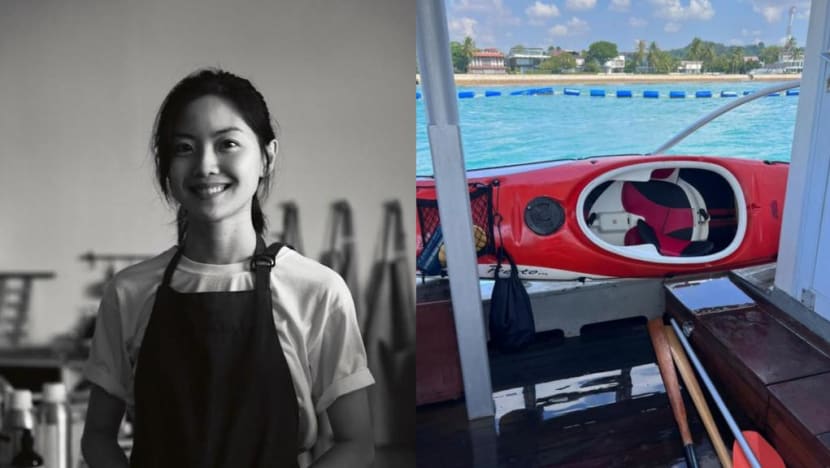'Selfless' kayaker drowned helping friend; coroner flags precautions to take when kayaking around Singapore
Ms Chew Jia Tian drowned after trying to help a struggling friend while they were kayaking off the south of Sentosa last October.


This audio is generated by an AI tool.
SINGAPORE: A kayaker who drowned trying to help a struggling friend in an act of "pure selflessness" died after her life jacket came off due to an unsecured crotch strap, a coroner's court ruled on Thursday (Aug 15).
Ms Chew Jia Tian, a 33-year-old Singaporean, had been kayaking with friends off the south of Sentosa on Oct 22, 2023.
She was trying to help a friend who had capsized near a line of blue floating security barriers, but could not paddle the combined weight of her friend and their two kayaks against the strong current there.
She later capsized, with her life jacket slipping off her as its crotch strap was not secured, and was found dead two days later with fractured ribs.
It was not determined whether she had sustained the fractures before or after her death.
In a set of written findings, State Coroner Adam Nakhoda said Ms Chew's decision to help her friend was "an act of pure selflessness".
He found that she "never gave up trying to paddle away" from the floating barriers, but her strength began to ebb away and she told her friend: "Sorry ... I can't."
The coroner said the tragic accident "resulted in the loss of a person in the prime of her life, who was simply pursuing one of her interests".
He flagged precautions that can be taken to minimise the risks of kayaking in the seas around Singapore.
These include:
- Complying with the Maritime and Port Authority of Singapore's circular No 11 of 2011 on "The use of canoes and kayaks within the port limits of Singapore", particularly by always using a personal flotation device and not paddling into prohibited areas
- Being aware of the location you are kayaking at, including understanding the sea state, tidal and current conditions
- Avoiding challenging sea areas like the vicinity of the Sentosa Beacon and the Buran Channel if you are an inexperienced kayaker
- Being aware of the difficulties that can be encountered as a result of currents pushing kayaks towards floating security barriers and what can be done to minimise this
- Always ensuring that appropriate safety equipment is used, and reading manufacturers' instructions for personal flotation devices to ensure they are suitable for planned trips
- Securing such devices as their manufacturers intended and using and securing crotch straps if they are present
- Performing checks to ensure that all kayakers in a group have the appropriate safety equipment and that flotation devices are fitted properly using all intended straps
Ms Chew was an experienced kayaker with her own kayak who had earned a two-star proficiency award in 2011 and attended a three-star course in January 2023.
ROUGH SEAS AROUND SINGAPORE
The area where Ms Chew and her friend's kayaks capsized was near the Sentosa Beacon, located at the island's southern tip and near the southern entrance to the Buran Channel, where waters merge and are rougher.
A harbour pilot and master mariner invited to give his opinion in the inquiry said all coastal areas around Singapore were susceptible to strong currents and choppy water or swells, which can be brought about by high winds during inclement weather and monsoon seasons.
He said areas susceptible to strong currents include the Buran Channel, Changi Beach Park, Sisters' Islands and the Southern Islands.
Sentosa is also susceptible to strong currents, especially at the Buran Channel and beyond the islets at Siloso, Palawan and Tanjong beaches.
These strong currents are not always visually apparent, and they could be difficult to navigate against, he said.
A lecturer in maritime training and a power pleasure craft driving licence examiner stated that inexperienced kayakers pinned against the blue barrels of floating security barriers could find it difficult to escape.
He said the worst-case scenario if a kayaker was caught against the barrels would be the kayaker rolling underneath them and getting trapped there.
He said kayakers should plan their trips before embarking on them, check the tides and ensure they have means of communication.
He added that the waters at the Buran Channel are generally rougher than they are elsewhere around Sentosa, even when the sea is calm in those areas.
FINDINGS ON THE LIFE JACKET
Of concern at the coroner's inquiry was the life jacket Ms Chew had used.
Her father had asked about the functionality of the device and whether it was faulty.
According to Ms Chew's husband, she had purchased a personal flotation device – referred to as a "BA50N Club buoyancy aid" in court documents – from Decathlon the day before the incident.
The life jacket was shaped like a singlet vest, with two shoulder straps connecting the rear portion to the front.
The life jacket also came with a crotch strap, and the device was designed to be worn with its side straps attached and tightened and with its crotch strap between the user's legs, secured by a clip.
Decathlon Singapore stated that the life jacket was intended for leisure water sports activities, including kayaking, stand-up paddle boarding and sailing.
The company spokesperson stated that the crotch strap had to be secured, and the failure to do so could result in the life jacket coming off if the user lifted their hands following a fall into the water.
It was emphasised that it was very unlikely that the life jacket would slip off in a fall if the side straps and crotch strap were properly secured.
Despite the opinion of a principal marine investigator who said Ms Chew had "bought a defective personal flotation device", the coroner found that the life jacket was not defective.
Ms Chew had secured its side straps properly, but she had not secured its crotch strap, which was later found tucked into front and rear pockets and unused.
The coroner conveyed his deepest condolences to Ms Chew's family and friends on their loss.














